The Wheelchair Guide
Your Wheelchair and Mobility Scooter Resource
The History of the Modern Manual Wheelchair
Friday, August 21st, 2009
Manual wheelchairs are one of the oldest types of wheelchairs known to man and records of their use can be traced back thousands of years. However, up until the end of the nineteenth century, there was very little standardization when it came to manual wheelchairs and they were often only available to people who had the resources to hire a professional builder.
Wicker and Wood: Early Wheelchair Designs
Towards the end of the nineteenth century, however, the wicker basket wheelchair began to become very popular. These wheelchairs provided a wicker seat for the person using the wheelchair, which had a very long and high back. These wicker wheelchairs had three wheels and were not only incredibly bulky, but also very heavy.
As a result of how these wheelchairs were designed, it was very difficult to transport a wicker wheelchair and it was also very difficult for the person using the wheelchair to move it on their own. Instead, they were forced to rely on nurses and family members to push the wheelchair if they wanted to move around.
In addition to the wicker wheelchairs, there were also several popular wooden wheelchairs, which were also incredibly heavy and difficult to transport, but were easier to self propel than the wicker wheelchair.
The Development of a Lighter Easier to Use Manual Wheelchair
Despite all their flaws, the wicker wheelchair would remain the standard in wheelchair design for over two decades until the 1930′s, when the first foldable tube framed manual wheelchair was developed. This new wheelchair was created by two inventors named Everest and Jennings and would come to be called the E & J Wheelchair.
Harry Jennings set out to build a newer lightweight wheelchair when he saw the difficulties his friend Herbert Everest was having using the standard wicker wheelchair. Together, they came up with a very innovative wheelchair design, which used hollow metal tubes and a foldable frame. By using metal tubes, they were able to create an incredibly strong wheelchair frame, which was also relatively lightweight.
The E & J Wheelchair frame could also be folded up and placed in a carriage or other vehicle, making easily traveling with a wheelchair possible for the first time. As the E & J Wheelchair was being developed, the build up to the Second World War was beginning and the E & J Wheelchair would soon have a number of users.
The First Electric Wheelchairs
The E & J wheelchair was also used as the base of the first electric wheelchair, when inventors in the 1950′s developed an electric motor that could be attached to the frame of an E & J wheelchair. This allowed the E & J wheelchair to be easily turned into an electric power chair and several companies began selling conversion kits for the E & J Frame.
The Wheelchairs of Today
The E & J manual wheelchair quickly became the standard and was used worldwide. Today, E & J wheelchairs are still available and their influence can be seen in virtually all modern manual wheelchairs.
Choosing the Right Electric Power Wheelchair
Friday, August 14th, 2009
For wheelchair users, the choice between an electric wheelchair and a manual wheelchair often revolves around the physical abilities of the wheelchair user. However, there are a number of other considerations, including personal preference, budget, and the place the wheelchair will be used.
For those that have decided to invest in an electric wheelchair, selecting the right power chair is very important, so it is important to understand some of their features and some of the different types of electric wheelchairs.
Rear-Wheel Drive Power Chairs vs Mid-Wheel Drive Power Chairs
There are several ways to categorize electric wheelchairs, but the drive system is one of the most important considerations. Power chairs are either driven by a mid-wheel drive system or a rear-wheel drive system. Understanding the difference between the two is important, because they both offer advantages and disadvantages.
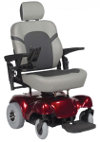 A rear-wheel drive power chair, as the name implies is driven by the rear wheels. Rear-wheel drive power chairs typically have only two sets of wheels, one in the front and one in the back, with the back wheels being responsible for moving the wheelchair. They may also have anti-tip casters, but as far as actual weight bearing wheels, there are usually only four. Since the weight of the wheelchair user is spread out evenly amongst the four wheels, the rear wheel drive system provides a very stable platform. This makes it a better choice for outdoor use or higher weight capacities.
A rear-wheel drive power chair, as the name implies is driven by the rear wheels. Rear-wheel drive power chairs typically have only two sets of wheels, one in the front and one in the back, with the back wheels being responsible for moving the wheelchair. They may also have anti-tip casters, but as far as actual weight bearing wheels, there are usually only four. Since the weight of the wheelchair user is spread out evenly amongst the four wheels, the rear wheel drive system provides a very stable platform. This makes it a better choice for outdoor use or higher weight capacities.
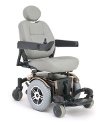 A mid-wheel drive power chair, on the other hand, has three sets of wheels and is driven by the middle set of wheels. This main advantage of a mid-wheel drive power chair is that it is very maneuverable, which results in a smaller turning radius than rear wheel drive system. However, the weight distribution is not as even on a mid wheel drive system, as the middle set of wheels supports the most weight. This makes them not quite as stable as a rear wheel drive system, but an excellent choice for indoor use, because mid-wheel drive wheelchairs are so very maneuverable.
A mid-wheel drive power chair, on the other hand, has three sets of wheels and is driven by the middle set of wheels. This main advantage of a mid-wheel drive power chair is that it is very maneuverable, which results in a smaller turning radius than rear wheel drive system. However, the weight distribution is not as even on a mid wheel drive system, as the middle set of wheels supports the most weight. This makes them not quite as stable as a rear wheel drive system, but an excellent choice for indoor use, because mid-wheel drive wheelchairs are so very maneuverable.
Portable Power Chairs vs Standard Power Chairs
Deciding whether to go with a portable power chair or a standard power chair is also an important consideration and depends a great deal on the needs of the user and where the electric wheelchair will be used.
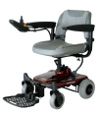 Portable power chairs, which are also sometimes called travel power chairs, are designed so that they can be taken apart into several easy to manage pieces. These individual pieces are light enough that they can usually be lifted by most people, so that the wheelchair can be transported without using a vehicle wheelchair lift. However, it is important to note that even though portable power chairs are designed to be as light as possible, the heaviest piece is usually around fifty pounds, so some might still find this too heavy to lift.
Portable power chairs, which are also sometimes called travel power chairs, are designed so that they can be taken apart into several easy to manage pieces. These individual pieces are light enough that they can usually be lifted by most people, so that the wheelchair can be transported without using a vehicle wheelchair lift. However, it is important to note that even though portable power chairs are designed to be as light as possible, the heaviest piece is usually around fifty pounds, so some might still find this too heavy to lift.
In order to reduce weight, portable power chairs have reduced features, such as smaller seats, and also typically have a slightly lower top speed, range, and weight capacity.
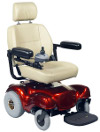 Standard Power Chairs, on the other hand, weigh a great deal more than portable power chairs and typically require a vehicle wheelchair lift to transport. Standard power chairs can typically still be easily disassembled, but the individual pieces are typically heavier than those of a portable power chair, with the heaviest piece usually weighing around ninety pounds.
Standard Power Chairs, on the other hand, weigh a great deal more than portable power chairs and typically require a vehicle wheelchair lift to transport. Standard power chairs can typically still be easily disassembled, but the individual pieces are typically heavier than those of a portable power chair, with the heaviest piece usually weighing around ninety pounds.
While standard power chairs are not as easily transported without a vehicle wheelchair lift, they are typically more comfortable and include more features. Standard power chairs usually have a more comfortable chair, a higher per-charge range, higher top speed, and a greater weight capacity than travel power chairs.
Increasing Accessibility With a Power Chair
Tuesday, August 11th, 2009
Today, many of those who use wheelchairs, opt to go with a electric wheelchair. Electric wheelchairs, which are also called power chairs, are popular for a number of reasons, including the fact that they can be operated with very little physical effort on the part of the wheelchair user.
Power chairs are not exactly a new invention and have been used for over fifty years. Back then, however, power chairs were simply manual wheelchairs that had been outfitted with an electric motor. The E & J Manual Wheelchair, which was incredibly popular at the time, actually had several do-it-yourself converter kits, which were sold to consumers, so they could transform their manual wheelchair into an electric wheelchair.
Today, power chairs remain to be very popular, but most do not share the same design as that of a manual wheelchair. Instead, most modern power chairs have a small plastic molded base, which contains the electric motor, axles, batteries, and other electrical components. A chair, often referred to as the captain’s chair, is attached to the base and often looks more like an office chair, complete with armrests, extra padding, headrest, and in some cases a reclining backrest.
Understanding Electric Wheelchair Controls
While the overall design of the power chair has greatly changed since it was first invented over fifty years ago, one thing that is still very similar is the default control system. The standard control system on electric wheelchairs is a joystick control that is attached to one of the chair’s armrest. This allows the power chair to be moved in any direction by the push of a button. However, unlike the original electric wheelchairs, modern wheelchairs also have a throttle setting to control the speed of the wheelchair. They are also much more sensitive than the first wheelchair controls, deftly turning and controlling the wheelchair in a very fluid motion.
While the joystick control system is the default control for most electric wheelchairs, there are many people who are unable to use it. For these people, a number of alternate controls are available, which can allow the power chair to be easily controlled even by people who are unable to move their hands.
Many of the popular alternate wheelchair controls are based around using the head. There are systems that allow the wheelchair to be controlled by head movements and also some that use the individuals breath to move the wheelchair. There are also a great number of experimental wheelchair controls in the works. This includes using magnets on the persons tongue and even several that rely on a brain computer interface, which uses signals from the users brain to control the electric wheelchair.
In addition to alternate control systems that make it easier for the wheelchair user to control their wheelchair, there are also a number of control schemes intended to make it easier for caretakers to move the wheelchair. The most basic is a simple remote control, either wireless or directly attached to the wheelchair, which can be used by someone walking next to the power chair. There are also much more advanced systems, which can learn the floor plans of a home or other area and then be programmed to move the wheelchair to any area in the home.
Electric wheelchairs are very powerful tools and remain to be one of the most popular accessibility tools. While these devices have been around for over fifty years, modern power chairs are much more reliable, durable, and powerful than their predecessors.
Modern Power Chairs
Wednesday, August 5th, 2009
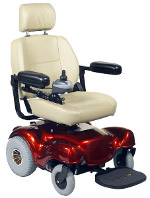 Electric wheelchairs, or power chairs, are today a very important accessibility aid that greatly improves the lives of millions of people every year. While modern power chairs offer similar functionality to the first electric wheelchairs developed almost 60 years ago, their design and reliability has changed a great deal.
Electric wheelchairs, or power chairs, are today a very important accessibility aid that greatly improves the lives of millions of people every year. While modern power chairs offer similar functionality to the first electric wheelchairs developed almost 60 years ago, their design and reliability has changed a great deal.
Power Chair Range and Speed
One of the biggest changes to the modern power chair is that it now uses a much stronger and more reliable electric motor. The batteries are also much improved, offering a much greater per charge distance. This not only means the wheelchair can be driven further faster, but also that it can support more weight and preform better over uneven terrain. It is not uncommon for an electric wheelchair to be able to travel more than 10 miles on a single charge, with a number of power chairs having a range between 15 and 20 miles. The top speed is also significantly higher, with most power chairs traveling at speeds at or above 5 miles per hour.
General Power Chair Design
While from a functionality and reliability standpoint, having an improved electrical system is one of the biggest differences between modern electric wheelchairs and their predecessors, there are also a significant number of changes involving the design of the device. The original electric wheelchairs were simply manual wheelchairs that had been outfitted with an electric motor and battery. However, today, most electric wheelchairs share a much different design.
This includes a much smaller molded plastic base, which contains the electrical components of the wheelchair. A seat is installed upon this plastic base and is usually referred to as the captain’s chair. Depending on the type of wheelchair, the captain’s chair could be relatively small, or it could resemble a high end office chair, with a high back and extended armrests. In either case, it is much different than the chair used on most manual wheelchairs, which is made out of slats of vinyl.
Power Chair Controls
There are in fact a great number of improvements and changes that have been made to the power chair over the years, many of these mechanical, but the standard electric wheelchair control scheme is the same. This is of course the joystick control system, which is found on most electric wheelchairs. The joystick is attached to the armrest of the wheelchairs chair and allows the power chair to be controlled by only the push of a finger.
There are also a number of alternate wheelchair controls that are commonly used, made available for people who are not able to physically able to use a standard joystick control scheme. There are many different types of controls, often aided by computers, allowing power chairs to be controlled by the angle of ones head, an individuals breath, or other parts of their body’s. For caretakers, there are also several popular remote control systems that can be attached to a standard power chair, allowing the unit to be controlled by someone walking behind it.
Even though the modern power chair shares a number of similarities with the first electric wheelchairs in regards to the functionality, they are actually quite different. Not only do they have a completely different design, but the modern power chair is much more reliable and durable.
Manual Wheelchairs vs Electric Wheelchairs
Monday, August 3rd, 2009
Wheelchairs are a popular mobility aid that greatly improves the lives of millions of people all over the world. The manual wheelchair has been around for thousands of years, while the electric wheelchair is relatively new, with the first electric wheelchair being developed in the early 1950′s. Choosing between a manual wheelchair or an electric wheelchair is an important decision that should be based upon the needs and requirements of its user.
Consider the Physical Capabilities of the User
One of the most important considerations when choosing between a manual or electric wheelchair is the physical abilities of the wheelchair user. Using a manual wheelchair requires a lot of upper body strength and can be very tiring even for someone who is in perfect health. In addition to having fairly good physical fitness, it is also necessary to use both arms to push a manual wheelchair.
An electric wheelchair, on the other hand, can be controlled by only using a single finger and there are also a number of other alternate controls as well. Alternate wheelchair controls include head controlled wheelchairs and breath controlled wheelchairs. This allows even someone with greatly reduced physical capabilities to use a wheelchair.
Consider Where the Wheelchair Will Be Used
In addition to considering the condition of the wheelchair user, it is also necessary to consider where the wheelchair will be used and how far it will be driven everyday. If the wheelchair is primarily going to be used around the home, then a manual wheelchair might be a good choice, because even though it requires a good deal of physical effort, moving between rooms does not present a very large traveling distance.
If, on the other hand, you intend to use the wheelchair away from home across a larger distance, an electric wheelchair might be a better choice. As an example, traveling across a college campus would be much more strenuous than traveling between rooms in a house. The per charge range of an electric wheelchair varies, but most can travel between 10 and 20 miles without needing to be recharged.
In addition to considering how far one will be traveling in the wheelchair, it is also important to consider what type of terrain will be traveled over. It takes much more effort to move up and down hills than it does to move across straight ground in a manual wheelchair. Some electric wheelchairs are also much better choices for off road use, although it is also possible to buy off road wheels for manual wheelchairs.
Consider the Cost of the Wheelchair
Finally, it is also important to consider the wheelchair users budget, when deciding between a manual wheelchair or an electric wheelchair. There are of course exceptions to the rule on both sides, but typically a manual wheelchair costs significantly less than an electric wheelchair. Usually a quality electric wheelchair costs between $3,500 and $7,000, while a manual wheelchair costs between $300 and $1,500.
When considering cost, it is important to take into account insurance programs, such as Medicare or Medicaid, which will often help to offset the cost of a wheelchair. For example, in the case of Medicare, typically 80% of the cost of the wheelchair is covered, so this can greatly offset the expense of an electric wheelchair.
Incline Platform Lifts and Vertical Platform Lifts
Wednesday, July 29th, 2009
Wheelchair users, both at home and away, usually have trouble with areas that have stairs. Areas with stairs can be very difficult for those using wheelchairs to access. Around the home, this can greatly decrease accessibility, as most homes have a staircase on the front of the home and may also have one inside. To help increase accessibility at home, many people use vertical platform lifts and inclined platform lifts, both of these devices greatly increase accessibility by allowing a wheelchair user full access to their home.
What are Vertical Platform Lifts?
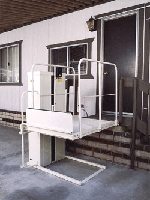 Vertical platform lifts, which are commonly called wheelchair lifts, are most often used on the front steps of a home. The entire unit is basically an elevator, with a strong lifting motor, elevator shaft, and lifting platform all rolled into one single unit.
Vertical platform lifts, which are commonly called wheelchair lifts, are most often used on the front steps of a home. The entire unit is basically an elevator, with a strong lifting motor, elevator shaft, and lifting platform all rolled into one single unit.
A wheelchair lift is placed next to the landing of a staircase. A large metal rectangle or square is provided, which the wheelchair user drives their wheelchair directly onto. The platform then raises vertically to the top of the landing and back down again. Depending on what type of vertical platform lift is used, there are many safety features available. For instance, many include locking doors on the platform, to reduce falls. It is also common for a door to be placed at the top of the landing.
Vertical platform lifts can usually support a minimum of 500 pounds, although this can vary by model, with some supporting more than 700 pounds. Due to their weight capacity, vertical platform lifts can be used by those with manual wheelchairs, electric wheelchairs, and mobility scooters. It is also often possible for multiple people to use the wheelchair lift at once, providing they do not exceed the weight capacity of the device.
While wheelchair lifts work very well on the front of the house, they do not always work on interior staircases. This is because the lift must be placed next to the landing and then raises the user up to the top of the landing. For many interior staircases, this setup just simply does not work.
Inclined Platform Lifts
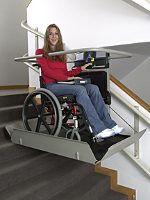 To provide interior access to a home with an interior staircase, it is often necessary to use an incline platform lift. Inclined platformed lifts provide a metal track that is attached to the wall of the staircase and runs its entire length. The wheelchair user is carried up the staircase on a platform, which is attached to the metal track.
To provide interior access to a home with an interior staircase, it is often necessary to use an incline platform lift. Inclined platformed lifts provide a metal track that is attached to the wall of the staircase and runs its entire length. The wheelchair user is carried up the staircase on a platform, which is attached to the metal track.
Inclined platform lifts can be used on most types of staircases, including curved ones. However, they do take up a good deal of space on the staircase. This is because the platform that carries the wheelchair user must be large enough for the person and their wheelchair, while also containing guard rails and an electric motor. So, an incline wheelchair lift may not fit on smaller staircases.
Inclined wheelchair lifts can usually be used by those in manual wheelchairs and electric wheelchairs, as well as people using mobility scooters. An incline platform lift operates very similarly to a stair lift, which is used by seniors who have difficulty using the stairs.
Both vertical platform lifts and inclined platform lifts are very popular in commercial settings, such as schools, churches, and office buildings.
Electric Wheelchairs of Today and Yesterday
Sunday, July 19th, 2009
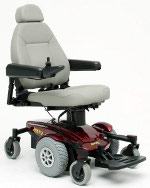 Today, electric wheelchairs are essential mobility vehicles, used by millions of people all over the world. Electric wheelchairs have changed a great deal over the last fifty years and remain incredibly popular, especially among those who are unable to use a manual wheelchair.
Today, electric wheelchairs are essential mobility vehicles, used by millions of people all over the world. Electric wheelchairs have changed a great deal over the last fifty years and remain incredibly popular, especially among those who are unable to use a manual wheelchair.
When electric wheelchairs, or power chairs, were first invented, an electric motor was placed onto a manual wheelchair, allowing it to be controlled electronically. This was a major improvement, which greatly increased the accessibility of those who were otherwise unable to get around by themselves. A number of companies quickly formed to sell these manual wheelchair converter kits, which were usually based off of the E & J Wheelchair.
While it is still possible to buy manual wheelchair converter kits, most electric wheelchairs today consist of a molded plastic base, which contains the electronic components of the wheelchair, with a large comfortable chair fitted onto the base. As a result, most modern electric wheelchairs can not be reverted into a manual wheelchair should the battery die, but they are much more powerful and often include a lot of neat features.
Most electric wheelchairs are controlled by using a simple joystick, which is secured to the arm of the chair. The joystick can be configured for left hand or right hand use, which is typically done by the manufacturer, although it is typically possible for the user to change this as well. In addition to the joystick, a simple throttle, which controls the speed of the wheelchair, is also usually on the arm of the chair. For those who are not able to use the standard wheelchair control, alternative controls are also available.
Many of todays electric wheelchairs share a number of similarities, both in the way they are designed, as well as the way they look. Typically, electric wheelchairs are classified by the type of drive system, either mid-wheel drive or rear wheel drive, as well as by how easy it is to transport the wheelchair.
In a mid-wheel drive electric wheelchair, the base of the wheelchair will typically have three rows of wheels. The middle row is the row that is responsible for moving and turning the wheelchair, while the other two rows help provide support. A mid-wheel drive system is extremely maneuverable, which makes it great for indoor use. In a rear wheel drive wheelchair, there will usually only be two rows of wheels, with the rear wheels being responsible for moving and turning. While not quite as maneuverable as a mid-wheel drive wheelchair, a rear wheel drive wheelchair does provide a little bit more stability because the weight is more evenly distributed between the base of the chair.
The other way that power chairs are classified is by how easy it is to transport them. Travel wheelchairs are available, which are designed to be taken apart to make it easier for them to be transported in a vehicle. There are even some folding electric wheelchairs, which closely resemble the design of a manual wheelchair. If you do not have a travel wheelchair, you will likely need a wheelchair lift to transport the device in a vehicle. This is because even though most electric wheelchairs can be disassembled, the individual pieces of a non-travel wheelchair can be very heavy.
The electric wheelchair has come a long way over the last fifty years and is today a very important tool for millions of people all across the World.
Prescribing a Wheelchair: Follow Up Care
Monday, July 13th, 2009
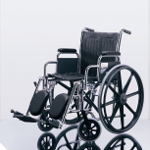 When a doctor prescribes a wheelchair to a user, it is very important that the wheelchair fits the needs of the user. It is also very important that the wheelchair user have a great deal of input over the process, because not only must their physical needs be met, but there are a number of other considerations, like where the person intends to primarily use their wheelchair, that should be considered.
When a doctor prescribes a wheelchair to a user, it is very important that the wheelchair fits the needs of the user. It is also very important that the wheelchair user have a great deal of input over the process, because not only must their physical needs be met, but there are a number of other considerations, like where the person intends to primarily use their wheelchair, that should be considered.
It is encouraged that new wheelchair users also talk with experienced wheelchair users and do a good deal of research on their own, because often doctors, while very well meaning, are not very experienced with wheelchairs and have never actually used one for an extended period of time. Due to health and safety concerns, it is very important that the wheelchair fits the physical requirements of the user.
Once the wheelchair arrives, everything should be remeasured and the wheelchair fully evaluated to ensure that it does in fact fit the needs of the user, however the doctors responsibility does not stop here. Instead, the wheelchair and its effect on the user should be reevaluated with each visit to the doctor.
One of the most important things that a doctor should look for is how the wheelchair is affecting the posture of its user. This is often something that can not be seen until after the user has been using the wheelchair for some time. Proper posture is essential for wheelchair users, because overtime a poor sitting position can cause a great number of health problems.
The actual condition of the wheelchair should also be checked and the user should be trained in how to properly maintain and care for their wheelchair. This includes lubricating moving parts, removing and cleaning the components, adjusting the anti-tip casters, and regularly checking the wheelchairs bolts for tightness. Emergency maintenance, such as how to fix a flat tire, should also be shown.
It is also very important that the wheelchair user be trained in how to navigate environmental factors that they might encounter. This includes the ability to move over curbs, navigate steps, and traveling on hills. Proper transfer techniques should also be shown and the user should be trained on how to fall out of the chair and recover. There are several places across the country that offer a sort of wheelchair obstacle course, to help train new wheelchair users and experienced wheelchair users alike.
The doctor should also make sure that the users home area is wheelchair friendly. It may be necessary to widen doors, install ramps, or a wheelchair lift. The doctor should talk with the patient and explain some of the options available.
Selecting the Right Wheelchair
Thursday, July 2nd, 2009
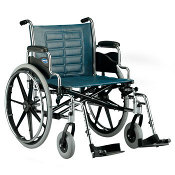 There are a number of decisions that go into prescribing a manual wheelchair and this decision should not be made lightly. This is because a wheelchair will be used daily and an improper fit could result in joint deformities, bruising, poor posture, circulation problems, and even pain. However, these problems can be avoided by ensuring that the wheelchair fits the user.
There are a number of decisions that go into prescribing a manual wheelchair and this decision should not be made lightly. This is because a wheelchair will be used daily and an improper fit could result in joint deformities, bruising, poor posture, circulation problems, and even pain. However, these problems can be avoided by ensuring that the wheelchair fits the user.
Size of the User
One of the most important considerations is the age of the wheelchair user, their size, and their weight. Wheelchairs come in a variety of sizes and so, it is seldom a problem finding one to fit an individual.
However, it is imperative that the seat is wide enough to accommodate their frame, the armrests do not rub their arms or cause discomfort, the backrest is not too high or too low, and the wheelchair can support the weight of the occupant. The height of the occupant is also important, so the wheelchair is not raised too high or low off of the ground.
Health and Condition of the User
The physical health and type of disability the new wheelchair user has is also a very important part of deciding what type of wheelchair will be the best choice. Since manual wheelchairs require good deal of upper body strength to use, they will not be the best choice for some, necessitating an electric power chair. Other considerations are the users ability to support their neck, how much flexibility they have in their legs, and circulation concerns, which could require the user to keep their feet elevated or have a reclining back.
Needs of the User
While the physical condition and attributes of the wheelchair user are essential, it is also imperative that the wheelchair can do what the user needs it to, so the needs and preferences of the wheelchair user should always be considered. For example, it should be determined if the user will be using the wheelchair only at home, at work, primarily outdoors, or a combination of all three. Other considerations include whether someone else will be pushing the wheelchair, how easy the wheelchair is to transport, and how the individual will transfer into and out of the chair.
Cost of the Wheelchair
Typically, the final consideration before actually ordering the wheelchair is the overall cost and purchasing power of the user. The order should be fine tuned to remove any unneeded features, which can add to the cost. The option to lease, buy, or rent should also be considered, as well as insurance or Medicare costs.
Ensuring that the wheelchair fits the specific needs and requirements of its user is imperative, not only for safety and health concerns, but also because the acceptance of a wheelchair by its user can affect their mental health.
Sports Wheelchair Parts Diagram
Tuesday, June 23rd, 2009
There are a great number of wheelchairs on the market and it is very important to find one that will fit the needs of its user. The sport wheelchair, or ultralight wheelchair, is very popular, both by people who are very active and those who simply find it easier and more comfortable to use.
*Please Note that some of the items below are not present in the picture, because they are not usually found on a sports wheelchair.
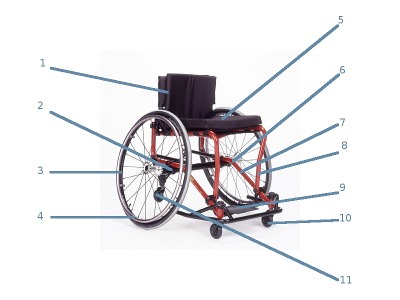
- Backrest
- Rear Axle
- Rear Wheels
- Handrims
- Seat
- Frame
- Traverse Bar
- Front Rigging
- Footrests
- Front Casters
- Anti-Tip Casters
- Brakes
- Tipping Levers
- Seatbelts
- Push Handles
- Upholstry
- Armrests
- Metal Skirt
1. Backrest: The backrest of a sports wheelchair is usually lower than a conventional wheelchair. Typically the backrest will be between 11†and 15â€. The backrest is also usually adjustable and models are also available that span 7†to 11†and 15†to 19â€. A lower backrest can allow for increased upper body movement.
2. Rear Axle: While on a conventional wheelchair, the axle is located directly below the backrest, many sports wheelchairs have adjustable axles. They can be positioned closer to the front of the chair, reducing the wheelbase and making the wheelchair more maneuverable. While typically much more maneuverable and easier to push, a smaller wheelbase also reduces the stability of the wheelchair. To increase stability, at the expense of maneuverability, the axle can be moved backwards towards the rear of the wheelchair. It also makes it a little harder to push, but increase the power of the stroke. Instead of a moving axle, some sports wheelchairs have a moving seat instead.
3. Rear Wheels: The rear wheels are usually the same size as on conventional wheelchairs, but sometimes for racing larger wheels are used. They feature sealed precision bearings and are designed to be as lightweight as possible. This makes the wheelchair easier to move and reduces friction. They also usually feature a quick release button, so the axle can be moved or wheel replaced quickly and easily. Most use spoked wheels, although some sports wheelchairs have solid molded rims.
Typically pneumatic tires are used, often allowing for a much higher pressure than traditional pneumatic tires. Pneumatic tires are great for outdoors, because they provide better shock absorption outdoors. Like racing bikes, the tires are often very narrow.
Often, the camber of the wheel, its angle, is often adjusted, much like you would adjust a sports car, with the bottom of the wheel farther out than the top. This brings the wheels closer to the users body, allowing for more energy efficiency. A wider wheelbase also offers the advantage of a more stable wheelchair that is also easier to steer.
This can pose a problem when indoors when dealing with narrow doorways and makes transporting the wheelchair more difficult. Some now allow the camber to be quickly adjusted to a “toe in†mode for indoor use though.
4. Handrims: The handrims are typically coated in foam that is covered in vinyl, although the rim itself is made of metal. This makes it easier to grab, however the vinyl can be very slick and result in finger burns. More or less padding can also be added, to deliver a variety of grip sizes.
Often smaller handrims are used, which require more energy to get started, but allow for a higher top speed. The smaller handrims also allow for the individual to maintain their speed easier. In many regards the size of the handrim is much like the different gears on a bike.
Sometimes for those with very limited upper body strength or mobility, small extensions are added to the handrail, which extend away from the wheelchair at an angle, making the wheels easier to turn.
5. Seat: The seat often has pieces of velcro attached to it, allowing cushions and bags to be attached. The lower backrest of the seat allows for a greater range of movement and slightly elevates the knees, improving stability.
6. Frame: The frame of a sports wheelchair is made of metals that are very lightweight, such as aluminum, titanium, and graphite. Often, the entire wheelchair will weigh only 25 pounds, which is about half of what a conventional wheelchair weights. There are some, however, that can weigh as little as 15 pounds. The lighter the frame, the easier it is to propel.
Traditionally the frame of sports wheelchairs had been rigid. This improved its performance and made it much sturdier, but it also made it harder to transport. The seat would have to be folded forward and the larger rear wheels would be removed. However, as of late, several manufacturers have begun making folding sports wheelchairs, which makes transportation much easier.
7. Traverse bar: The traverse bar replaces the crossbars found on conventional wheelchairs and helps make the frame sturdier. On folding sports wheelchairs, the frames are equipped with locks to prevent it from folding unless needed.
8. Front Rigging: The front rigging refers to the footrest and the bars that connect it to the frame. Traditionally, the front rigging was not detachable, which improved the stability of the frame. However, this could make transferring into and out of the chair more difficult, some some sports wheelchairs now feature detachable and swing away front rigging.
9. Footrests: The footrest is typically one piece and made of several metal tubes, instead of a platform. It is usually closer to the frame than conventional wheelchairs, reducing the sports wheelchairs turning radius.
10. Front Casters: The front casters are typically made out of solid polyurethane, although some use pneumatic or solid rubber tires. The casters are smaller than those on a conventional wheelchair, usually only 4†to 5†in diameter. However, on racing wheelchairs larger front casters are often used.
11. Anti-Tip Casters: Anti-Tip casters prevent the wheelchair from tipping backwards completely and are often not included on newer wheelchairs.
12. Brakes: Most sports wheelchairs do not have brakes, although some choose to use them. If used, scissor brakes are most popular and mounted lower down on the frame, so the users hand does not become entangled when pushing or the brake accidentally activated. (Not Pictured)
13. Tipping Levers: Typically the tipping lever, which makes it easier for someone pushing the wheelchair to tip the wheelchair backwards and navigate curbs, are much smaller than those on conventional wheelchairs. (Not Pictured)
14. Seatbelts: Seatbelts are usually available for most sports wheelchairs as an option. Some wheelchair users that are very active will use a safety harness to provide more support. (Not Pictured)
15. Push Handles: Many sports wheelchairs do not have push handles, because of the added weight. Instead, fabric straps are added to the back of the seat, to provide a handhold. Some, however, do have push handles. (Not Pictured)
16. Upholstry: Most sports wheelchairs have reinforced nylon or darcon upholstry. This is very lightweight and strong, but unlike vinyl, it is not as easy to clear. (Not Pictured)
17. Armrests: Most sports wheelchairs do not have armrest, which reduces the weight, while allowing the user a better pushing angle. It also increases the users range of upper body movement. (Not Pictured)
If armrests are present, they are usually lightweight and removable. Typically they are not strong enough for the user to use them to transfer into and out of the wheelchair.
18. Metal Skirt: A metal skirt is also usually not present, for both wheelchairs with and without armrests, so the user will risk dirtying their clothes or catching them in the wheels. (Not Pictured)
Other Types of Sports Wheelchairs
There are many different popular wheelchair sports and almost all of these types of sports use a slightly different wheelchair design. For example, the footrest and front rigging of a wheelchair that will be used for wheelchair basketball has a built in foot guard to add more protection. Wheelchairs for wheelchair rugby have an even more protective front guard, as well as more protection around the wheels.
Wheelchairs that are used for racing are elongated to provide stability, so the front wheels often extend several feet from the wheelchairs seat. Since there is so much diversity among the design of sports wheelchair, it is important to decide what you want to use the wheelchair for and to speak with a professional or other wheelchair user to determine what type of wheelchair will be best. It is also not uncommon for many wheelchair users to prefer the design of a sports wheelchair, even if they do not intend to directly use it to play sports.